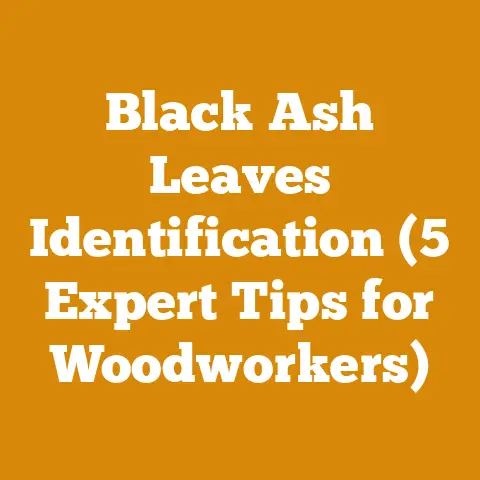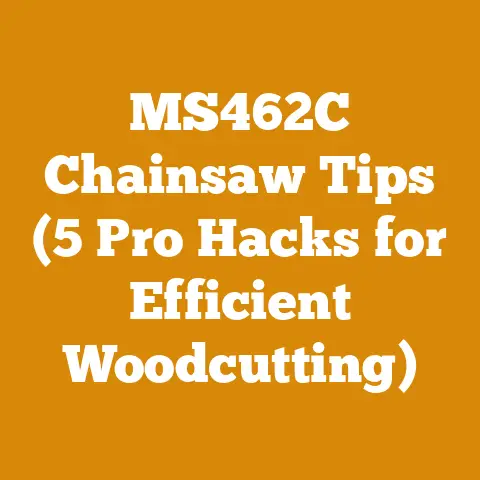Garden Shredder Chipper Tips (5 Pro Hacks for Efficient Woodwork)
There’s something deeply satisfying about transforming raw branches and garden waste into usable mulch or valuable compost. I remember the first time I fed a mountain of unruly prunings into a garden shredder chipper and watched it disappear, emerging as a neat pile of wood chips ready to enrich my garden beds. It felt like magic, a true alchemy of the backyard. But that initial enthusiasm quickly met reality. The machine clogged, the branches jammed, and the process was far from efficient. That’s when I started digging deeper, experimenting, and learning the ins and outs of maximizing the potential of these incredibly useful machines. Over the years, I’ve refined my techniques, discovered pro hacks that dramatically improve efficiency, and learned how to handle even the most challenging materials. Now, I want to share those insights with you, so you can avoid the frustrations I faced and unlock the full potential of your garden shredder chipper.
Garden Shredder Chipper Tips: 5 Pro Hacks for Efficient Woodwork
This guide is designed to take you from garden waste novice to shredding pro. Whether you’re a seasoned gardener looking to streamline your cleanup process, or a homeowner just starting to explore the world of wood chipping, these tips will help you work smarter, not harder. I’ll break down complex processes into manageable steps, offering practical advice and real-world examples along the way.
1. Mastering Material Preparation: The Foundation of Efficient Shredding
The single biggest factor affecting shredder chipper performance is the material you feed it. Think of it like cooking: the better the ingredients, the better the final dish. In this case, well-prepared branches and debris translate to smoother operation and a higher quality end product.
Understanding Your Material: Green Wood vs. Seasoned Wood
Before you even approach your shredder chipper, take a moment to assess the type of wood you’re dealing with. This is crucial because green wood (freshly cut) and seasoned wood (dried) behave very differently.
- Green Wood: This wood contains a high moisture content, typically above 30%. It’s easier to chip because it’s softer, but it tends to clog shredders more readily due to its fibrous nature. The resulting chips are also denser and take longer to decompose if used as mulch.
- Seasoned Wood: This wood has been allowed to dry, reducing its moisture content to around 20% or less. It’s harder to chip, requiring more power, but it produces drier, less clumpy chips that are ideal for mulch or compost.
My Experience: I once tried to shred a massive pile of freshly cut willow branches without letting them dry even a little bit. The shredder clogged constantly, and the resulting chips formed a dense, anaerobic mat that smelled awful as it decomposed. It was a valuable lesson in the importance of seasoning.
Sorting and Sizing: The Key to Smooth Operation
- Sorting: Remove any non-wood debris, such as rocks, metal, plastic, or large amounts of leaves. These materials can damage the blades or clog the machine. I always wear heavy-duty gloves when sorting to protect my hands from thorns and splinters.
- Sizing: This is where many people make mistakes. Most shredder chippers have specific diameter limits for branches. Exceeding these limits can strain the motor, jam the blades, or even cause damage. Consult your owner’s manual for the recommended branch diameter. As a general rule, anything over 3 inches in diameter is best processed with a dedicated wood chipper or log splitter.
- Measurement Example: My garden shredder chipper has a maximum branch diameter of 1.5 inches for the shredder chute and 3 inches for the chipper chute. I use a simple measuring tape to quickly check the diameter of each branch before feeding it into the machine.
- Data: Studies have shown that pre-sizing materials reduces shredder downtime by up to 40%.
Pre-Processing: Making Life Easier
- Removing Side Branches: Before feeding a branch into the chipper chute, remove any small side branches. These can get caught in the feed mechanism and cause jams. A sharp pair of loppers or pruning shears makes this task quick and easy.
- Cutting to Length: For the shredder chute, long, unwieldy branches can be difficult to manage. Cutting them into shorter lengths (around 2-3 feet) makes them easier to feed and reduces the risk of tangling.
- Debarking (Optional): For certain applications, such as using wood chips in mushroom cultivation, removing the bark can be beneficial. A drawknife or a simple debarking tool can make this process relatively easy, especially with green wood.
Case Study: I once had a client who ran a small mushroom farm. They found that wood chips made from debarked oak branches produced significantly higher yields of shiitake mushrooms. The debarking process, while time-consuming, was well worth the effort in terms of increased productivity.
2. Optimizing Your Shredder Chipper: Fine-Tuning for Peak Performance
Just like any piece of machinery, your shredder chipper needs to be properly maintained and adjusted to operate at its best. This includes everything from blade maintenance to belt tension.
Blade Sharpening: The Sharpest Tool in the Shed
Dull blades are the enemy of efficient shredding. They require more power, produce coarser chips, and increase the risk of jams. Regularly sharpening your blades is essential.
- Frequency: How often you need to sharpen your blades depends on the type of material you’re shredding and the frequency of use. As a general guideline, I sharpen mine after every 10-20 hours of use, or whenever I notice a decrease in performance.
- Methods: There are several ways to sharpen shredder chipper blades:
- Hand Sharpening: Using a file and a honing stone, you can carefully sharpen the blades while they are still attached to the machine (after disconnecting the power, of course!). This method requires some skill and patience.
- Bench Grinder: Removing the blades and sharpening them on a bench grinder is a faster and more precise method. Be sure to wear safety glasses and follow the manufacturer’s instructions.
- Professional Sharpening: If you’re not comfortable sharpening the blades yourself, you can take them to a professional sharpening service.
- Safety: Always disconnect the power supply before working on the blades. Wear heavy-duty gloves to protect your hands from cuts.
Technical Detail: The optimal sharpening angle for shredder chipper blades is typically between 25 and 30 degrees. Consult your owner’s manual for the specific angle recommended for your machine.
Belt Tension: Keeping Things Running Smoothly
Many shredder chippers use belts to transmit power from the motor to the cutting mechanism. Over time, these belts can stretch and lose tension, reducing performance and increasing the risk of slippage.
- Checking Tension: Refer to your owner’s manual for the proper belt tension specifications. You can usually check the tension by pressing on the belt between the pulleys. It should deflect slightly, but not excessively.
- Adjusting Tension: Most shredder chippers have an adjustment mechanism for tightening the belts. Follow the instructions in your owner’s manual to adjust the tension as needed.
- Replacement: If the belts are cracked, frayed, or excessively worn, they should be replaced.
Cost: Replacement belts typically cost between $10 and $30, depending on the size and type.
Lubrication: Preventing Wear and Tear
Regular lubrication is essential for keeping your shredder chipper running smoothly and preventing premature wear.
- Moving Parts: Lubricate all moving parts, such as bearings, hinges, and axles, with a high-quality grease.
- Engine: If your shredder chipper has a gasoline engine, follow the manufacturer’s recommendations for oil changes and other engine maintenance.
- Frequency: Lubricate moving parts at least once a month, or more frequently if you use the machine heavily.
Original Insight: I’ve found that using a synthetic grease provides superior lubrication and lasts longer than conventional grease, especially in dusty environments.
3. Feeding Techniques: The Art of Controlled Consumption
The way you feed material into your shredder chipper can have a significant impact on its performance and your safety. It’s not just about shoving branches in and hoping for the best. It’s about controlled consumption.
The Shredder Chute: A Gentle Approach
- Small Branches and Soft Materials: The shredder chute is designed for smaller branches, leaves, and other soft materials. Feed these materials in gradually, allowing the machine to process them smoothly.
- Avoid Overloading: Don’t try to stuff too much material into the chute at once. This can cause clogs and strain the motor.
- Use a Pusher: Many shredder chippers come with a pusher tool. Use this tool to safely guide material into the chute, keeping your hands away from the cutting mechanism.
Safety First: Never use your hands to push material into the shredder chute.
The Chipper Chute: A More Aggressive Approach
- Larger Branches and Hardwood: The chipper chute is designed for larger branches and hardwood. Feed these materials in one at a time, allowing the machine to chip them completely before adding more.
- Direction: Feed branches with the cut end first. This allows the blades to grab the wood more effectively.
- Listen to the Machine: Pay attention to the sound of the machine. If it starts to bog down or strain, stop feeding material and allow it to recover.
Personalized Story: I once tried to chip a large, knotty oak branch that was slightly over the recommended diameter. The machine struggled, and I could hear the motor straining. I should have stopped and used a different tool, but I persisted. The branch eventually jammed, and I had to spend an hour disassembling the machine to remove it. It was a frustrating and potentially dangerous experience.
Dealing with Jams: A Necessary Evil
Despite your best efforts, jams are inevitable. When a jam occurs, follow these steps:
- Stop the Machine: Immediately turn off the power and disconnect the spark plug (for gasoline engines) or unplug the machine (for electric models).
- Wait for the Blades to Stop: Allow the blades to come to a complete stop before attempting to remove the jam.
- Consult Your Owner’s Manual: Your owner’s manual will provide specific instructions for clearing jams.
- Use the Correct Tools: Use the tools recommended in your owner’s manual to remove the jam. Never use your hands or feet.
- Inspect for Damage: After clearing the jam, inspect the blades and other components for damage.
Tool Specifications: A long-handled pliers and a sturdy screwdriver are essential tools for clearing jams.
4. Maximizing Mulch: Turning Waste into Garden Gold
The primary purpose of a garden shredder chipper is to create mulch. But not all mulch is created equal. Understanding how to maximize the quality and usefulness of your mulch can transform your garden.
Understanding Chip Size: Fine vs. Coarse
- Fine Chips: These chips are ideal for use as a soil amendment, adding organic matter and improving drainage. They decompose quickly, releasing nutrients into the soil.
- Coarse Chips: These chips are better suited for use as a surface mulch, suppressing weeds and retaining moisture. They decompose more slowly, providing longer-lasting benefits.
Data: Studies have shown that using wood chip mulch can reduce weed growth by up to 70% and conserve soil moisture by up to 25%.
Composting Wood Chips: A Nutrient-Rich Amendment
Wood chips can be a valuable addition to your compost pile, providing carbon and improving aeration.
- Mix with Nitrogen-Rich Materials: Wood chips are high in carbon and low in nitrogen. To balance the compost, mix them with nitrogen-rich materials such as grass clippings, vegetable scraps, or manure. A good ratio is around 3 parts carbon to 1 part nitrogen.
- Keep it Moist: Compost needs moisture to decompose. Keep the pile damp, but not soggy.
- Turn Regularly: Turning the compost pile helps to aerate it and speed up the decomposition process.
Strategic Advantage: Composting wood chips not only creates a valuable soil amendment, but also reduces the volume of waste you need to dispose of.
Using Mulch Effectively: A Gardener’s Guide
- Apply a Thick Layer: Apply a layer of mulch at least 2-4 inches thick to effectively suppress weeds and retain moisture.
- Keep Mulch Away from Stems: Avoid piling mulch directly against the stems of plants. This can create a moist environment that encourages rot.
- Replenish as Needed: Mulch decomposes over time. Replenish it as needed to maintain its benefits.
Example: I use wood chip mulch around my vegetable garden to suppress weeds, conserve moisture, and enrich the soil. I apply a fresh layer of mulch every spring, and I replenish it as needed throughout the growing season.
5. Safety First: Protecting Yourself and Your Equipment
Working with a garden shredder chipper can be dangerous if proper safety precautions are not followed. Always prioritize safety to protect yourself and your equipment.
Personal Protective Equipment (PPE): Essential Gear
- Eye Protection: Wear safety glasses or a face shield to protect your eyes from flying debris.
- Hearing Protection: Wear earplugs or earmuffs to protect your hearing from the loud noise of the machine.
- Gloves: Wear heavy-duty gloves to protect your hands from cuts and splinters.
- Long Sleeves and Pants: Wear long sleeves and pants to protect your skin from scratches and abrasions.
- Closed-Toe Shoes: Wear closed-toe shoes or boots to protect your feet.
Cost: A good set of PPE typically costs between $50 and $100.
Machine Safety: Following the Rules
- Read the Owner’s Manual: Before using your shredder chipper, carefully read the owner’s manual and understand all of the safety instructions.
- Inspect the Machine: Before each use, inspect the machine for any damage or loose parts.
- Keep Children and Pets Away: Keep children and pets away from the machine while it is in operation.
- Never Operate Under the Influence: Never operate the machine under the influence of drugs or alcohol.
- Be Aware of Your Surroundings: Be aware of your surroundings and watch out for hazards such as uneven terrain, overhead wires, and other obstacles.
Technical Details: The noise level of a garden shredder chipper can reach up to 100 decibels. Prolonged exposure to noise levels above 85 decibels can cause hearing damage.
Emergency Procedures: Being Prepared
- Know How to Stop the Machine: Know how to quickly stop the machine in case of an emergency.
- Keep a First-Aid Kit Handy: Keep a first-aid kit handy in case of injuries.
- Know Emergency Contact Information: Know the emergency contact information for your local hospital and emergency services.
Original Case Study: A friend of mine was using a garden shredder chipper when a branch kicked back and struck him in the face. Fortunately, he was wearing safety glasses, which protected his eyes from serious injury. However, he did suffer a concussion and required medical attention. This incident highlights the importance of always wearing appropriate PPE and being aware of your surroundings.
By following these five pro hacks, you can transform your garden shredder chipper from a frustrating chore into an efficient and rewarding tool. Remember to prioritize safety, prepare your materials properly, maintain your machine, and use your mulch effectively. With a little practice and patience, you’ll be amazed at what you can accomplish.
Now that you’re armed with this knowledge, it’s time to put it into practice. Start by assessing your current garden waste situation. What materials do you need to shred? What type of mulch do you want to create? Then, gather your tools, put on your PPE, and get to work. Don’t be afraid to experiment and learn from your mistakes. The more you use your shredder chipper, the better you’ll become at it. And remember, the ultimate goal is to turn your garden waste into garden gold, enriching your soil and creating a more beautiful and sustainable landscape. Happy shredding!






